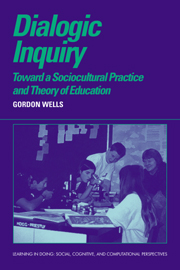Book contents
- Frontmatter
- Contents
- Conventions of Transcription
- Introduction
- Part I Establishing the Theoretical Framework
- Part II Discourse, Learning, and Teaching
- 4 Text, Talk, and Inquiry: Schooling As Semiotic Apprenticeship
- 5 Putting a Tool to Different Uses: A Reevaluation of the IRF Sequence
- 6 From Guessing to Predicting: Progressive Discourse in the Learning and Teaching of Science
- 7 Using the Tool-kit of Discourse in the Activity of Learning and Teaching
- 8 Making Meaning with Text: A Genetic Approach to the Mediating Role of Writing
- Part III Learning and Teaching in the zpd
- Appendix I A Social Constructivist Model of Learning and Teaching
- Appendix II Categories for the Analysis of Discourse
- References
- Index of Authors
- Index of Subjects
- Title in the series
5 - Putting a Tool to Different Uses: A Reevaluation of the IRF Sequence
Published online by Cambridge University Press: 09 November 2009
- Frontmatter
- Contents
- Conventions of Transcription
- Introduction
- Part I Establishing the Theoretical Framework
- Part II Discourse, Learning, and Teaching
- 4 Text, Talk, and Inquiry: Schooling As Semiotic Apprenticeship
- 5 Putting a Tool to Different Uses: A Reevaluation of the IRF Sequence
- 6 From Guessing to Predicting: Progressive Discourse in the Learning and Teaching of Science
- 7 Using the Tool-kit of Discourse in the Activity of Learning and Teaching
- 8 Making Meaning with Text: A Genetic Approach to the Mediating Role of Writing
- Part III Learning and Teaching in the zpd
- Appendix I A Social Constructivist Model of Learning and Teaching
- Appendix II Categories for the Analysis of Discourse
- References
- Index of Authors
- Index of Subjects
- Title in the series
Summary
If there is one finding on which students of classroom discourse are agreed, it must be the ubiquity of the three-part exchange structure that Lemke (1985, 1990) calls “triadic dialogue.” In its prototypical form, this discourse format consists of three moves: an initiation, usually in the form of a teacher question, a response, in which a student attempts to answer the question, and a follow-up move, in which the teacher provides some form of feedback to the student's response. Actual frequencies of occurrence vary considerably, of course, but in many secondary classrooms it is estimated that this format accounts for some 70 percent of all the discourse that takes place between teacher and students, and even in some primary classrooms it has been found to be the dominant mode in which the teacher converses, even when talking with individual students.
When it comes to evaluating the educational significance of this mode of classroom discourse, on the other hand, there is much less agreement. Sinclair and Coulthard (1975), for example, seem to assume that triadic dialogue simply is the unmarked mode of classroom interaction: Unless there is a good reason to behave otherwise, teachers adopt this mode by default. Not surprisingly, therefore, they offer no evaluation of its educational effectiveness. Others, by contrast, while accepting its pervasiveness, claim that it is, in fact, functionally effective. Mercer (1992), for example, argues that triadic dialogue is justified as an effective means of: “monitoring children's knowledge and understanding,” “guiding their learning,” and “marking knowledge and experience which is considered educationally significant or valuable.”
- Type
- Chapter
- Information
- Dialogic InquiryTowards a Socio-cultural Practice and Theory of Education, pp. 167 - 208Publisher: Cambridge University PressPrint publication year: 1999
- 3
- Cited by



